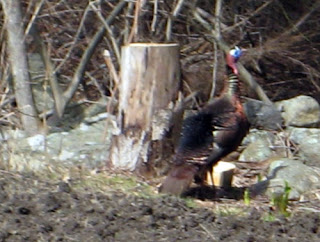1. That floppy protrusion on a turkey's head is called the caruncle. An agitated turkey's caruncle will grow longer and hang over its beak. The fleshy skin under its chin is called the wattles. 2. Male turkeys gobble to show they are dominant. The sound can be heard a mile away. 3. Male turkeys have spurs on their legs that they use to fight other toms and to fend off predators. 4. Turkeys prefer to run from danger. But they can fly, sometimes as fast as 50 mph. 5. Domesticated turkeys usually have white feathers and are much too heavy to get off the ground. 6. To stay safe from predators turkeys roost in trees at night. 7. A turkey has binocular, or 3-D, vision. It can spot movement a hundred yards away. 8. Although turkeys don't have external ears, their hearing is sharp. 9. Female turkeys lay between 8 to 18 tan eggs. The hatchlings are called poults. 10. While wild turkeys have the capacity to live to about 12, most don't make it past two. And for domesticated turkeys it's half that.
I found most of these facts in All About Turkeys, written and illustrated by Jim Arnosky. Published in 1998, Arnosky's book remains a good introduction to the bird that was Ben Franklin's choice for the United States national bird. Wild Turkeys by Dorothy Hinshaw Patent and illustrated by William Munoz provides additional information for kids to chew on.
Today's host for Nonfiction Monday is Practically Paradise.
0 Comments on Ten Things You Might Not Know About Turkeys as of 1/1/1900
Add a Comment







An excellent visitor.
Wish I had garden beds to prep!
You've got a puppy. Far more work!! ;-)